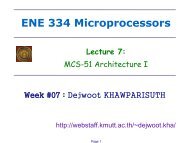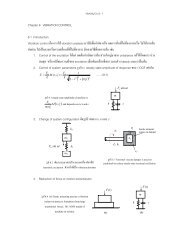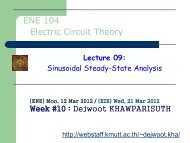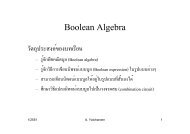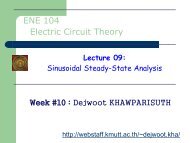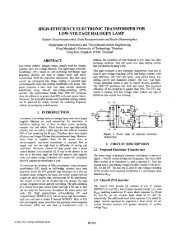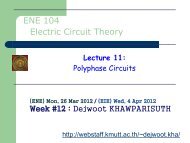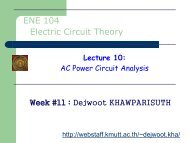Model-based fault-detection and diagnosis ... - web page for staff
Model-based fault-detection and diagnosis ... - web page for staff
Model-based fault-detection and diagnosis ... - web page for staff
You also want an ePaper? Increase the reach of your titles
YUMPU automatically turns print PDFs into web optimized ePapers that Google loves.
Table 7<br />
Methods of <strong>fault</strong> <strong>diagnosis</strong><br />
determined experimentally <strong>for</strong> certain <strong>fault</strong>s Fj. The<br />
relationship between F <strong>and</strong> S is there<strong>for</strong>e learned (or<br />
trained) experimentally <strong>and</strong> stored, <strong>for</strong>ming an explicit<br />
knowledge base. By comparison of the observed S with the<br />
normal reference S n, <strong>fault</strong>s F can be concluded.<br />
One distinguishes between statistical or geometrical<br />
classification methods, with or without certain probability<br />
functions (Tou & Gonzalez, 1974). A further possibility is<br />
the use of neural networks because of their ability to<br />
approximate non-linear relations <strong>and</strong> to determine flexible<br />
decision regions <strong>for</strong> F in continuous or discrete <strong>for</strong>m<br />
(Leonhardt, 1996). By fuzzy clustering the use of fuzzy<br />
separation areas is possible.<br />
3.2. Inference methods<br />
For some technical processes, the basic relationships<br />
between <strong>fault</strong>s <strong>and</strong> symptoms are at least partially known.<br />
Then this a priori knowledge can be represented in causal<br />
relations: <strong>fault</strong> ! events ! symptoms. Table 7 shows a<br />
simple causal network, with the nodes as states <strong>and</strong> edges as<br />
relations. The establishment of these causalities follows the<br />
<strong>fault</strong>-tree analysis (FTA), proceeding from <strong>fault</strong>s through<br />
intermediate events to symptoms (the physical causalities)<br />
or the event-tree analysis (ETA), proceeding from the<br />
symptoms to the <strong>fault</strong>s (the diagnostic <strong>for</strong>ward-chaining<br />
causalities). To per<strong>for</strong>m a <strong>diagnosis</strong>, this qualitative<br />
R. Isermann / Annual Reviews in Control 29 (2005) 71–85 77<br />
knowledge can now be expressed in <strong>for</strong>m of rules: IF<br />
THEN . The condition part<br />
(premise) contains facts in the <strong>for</strong>m of symptoms Si as<br />
inputs, <strong>and</strong> the conclusion part includes events Ek <strong>and</strong> <strong>fault</strong>s<br />
Fj as a logical cause of the facts. If several symptoms<br />
indicate an event or <strong>fault</strong>, the facts are associated by AND<br />
<strong>and</strong> OR connectives, leading to rules in the <strong>for</strong>m<br />
IF < S 1 AND S 2 > THEN <br />
IF < E 1 OR E 2 > THEN .<br />
For the establishment of this heuristic knowledge several<br />
approaches exist, see (Torasso & Console, 1974). In the<br />
classical <strong>fault</strong>-tree analysis the symptoms <strong>and</strong> events are<br />
considered as binary variables, <strong>and</strong> the condition part of the<br />
rules can be calculated by Boolean equations <strong>for</strong> parallelserial-connection,<br />
see, e.g. (Barlow & Proschan, 1975; Freyermuth,<br />
1993). However, this procedure has not proved to<br />
be successful because of the continuous nature of <strong>fault</strong>s <strong>and</strong><br />
symptoms. For the <strong>diagnosis</strong> of technical processes approximate<br />
reasoning is more appropriate. A recent survey on<br />
learning methods <strong>for</strong> rule-<strong>based</strong> <strong>diagnosis</strong> is given in (Füssel<br />
& Isermann, 2000).<br />
The summary of some basic <strong>fault</strong>-<strong>detection</strong> <strong>and</strong> <strong>diagnosis</strong><br />
methods presented in Sections 2 <strong>and</strong> 3 was limited to linear<br />
processes mainly. Some of the methods can also be directly<br />
applied <strong>for</strong> non-linear processes, as e.g., signal analysis,<br />
parity equations <strong>and</strong> parameter estimation. However, all the<br />
methods have to be adapted to the real processes. In this<br />
sense the basic methods should be considered as ‘‘tools’’,<br />
which have to be combined properly in order to meet the<br />
practical requirements <strong>for</strong> real <strong>fault</strong>s of real processes.<br />
4. Applications of model- <strong>and</strong> signal-<strong>based</strong> <strong>fault</strong><br />
<strong>diagnosis</strong><br />
In the following some results from case studies <strong>and</strong> indepth<br />
investigations of model-<strong>based</strong> <strong>fault</strong>-<strong>detection</strong> methods<br />
are briefly described. The examples are selected such that<br />
they show different approaches <strong>and</strong> process adapted<br />
solutions which can be transferred to other similar technical<br />
processes.<br />
4.1. Fault <strong>diagnosis</strong> of a cabin pressure outflow valve<br />
actuator of a passenger aircraft<br />
The air pressure control in passenger aircraft is manipulated<br />
by DC motor driven outflow valves. The design of the<br />
outflow valve is made <strong>fault</strong> tolerant by two brushless DC<br />
motors which operate over the gear to a lever mechanism<br />
moving the flap, Fig. 5. The two DC motors <strong>for</strong>m a<br />
duplex system with dynamic redundancy <strong>and</strong> cold st<strong>and</strong>by,<br />
Fig. 6. There<strong>for</strong>e, a <strong>fault</strong>-<strong>detection</strong> <strong>for</strong> both DC motors is<br />
required to switch from the possibly <strong>fault</strong>y one to the<br />
st<strong>and</strong>by motor.




